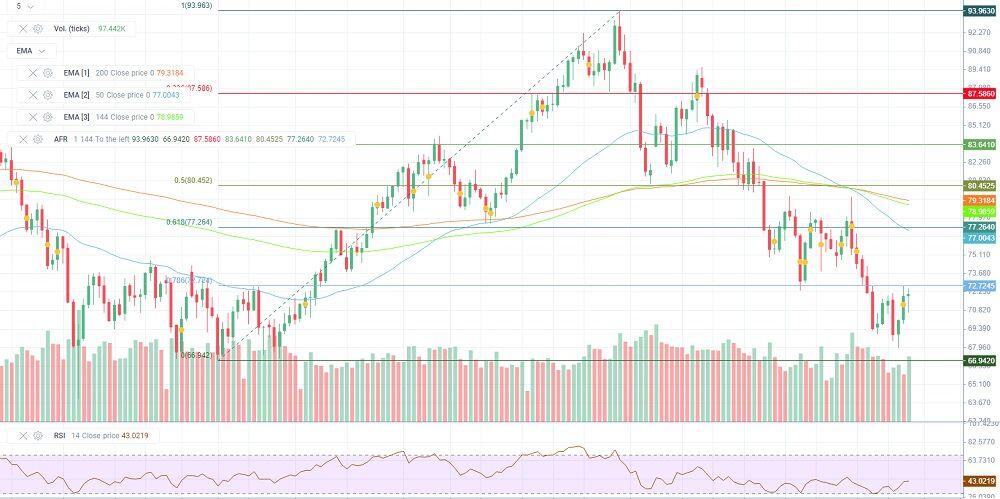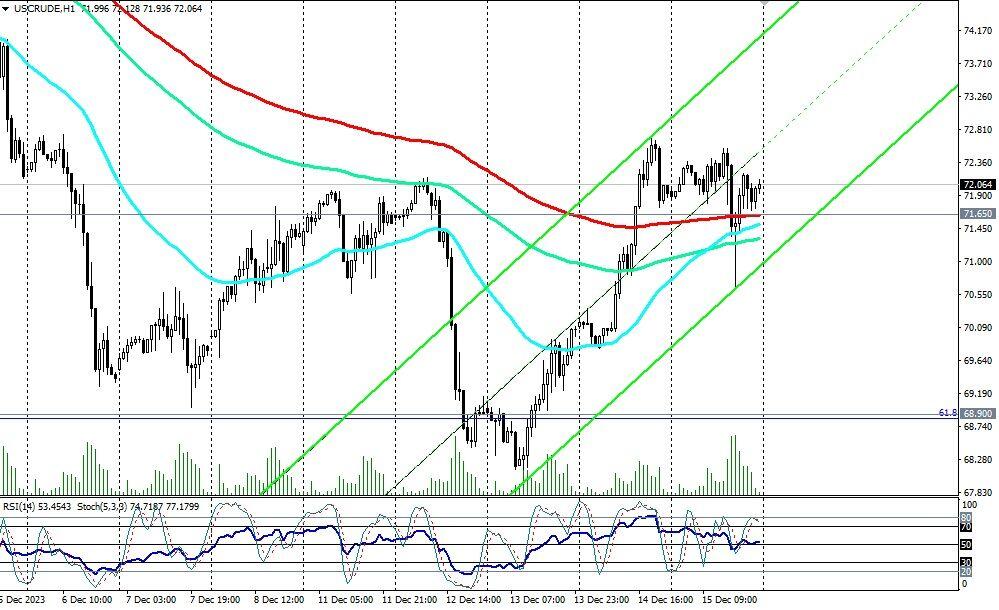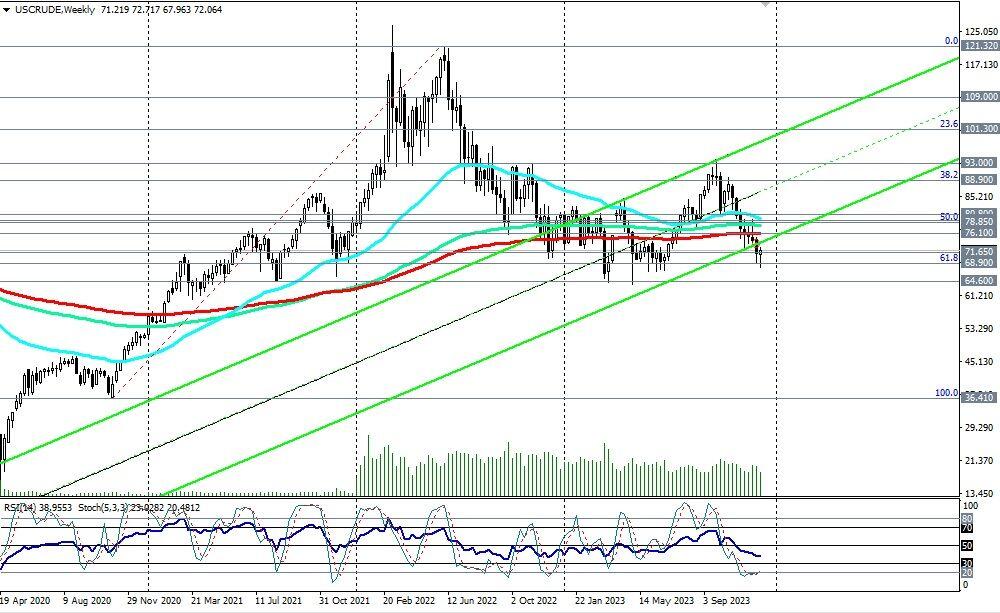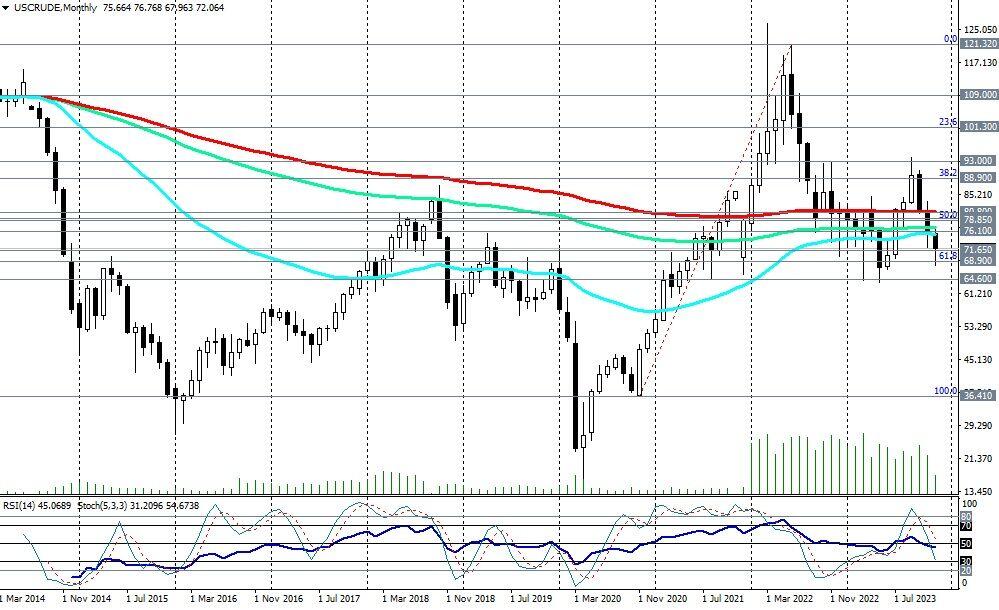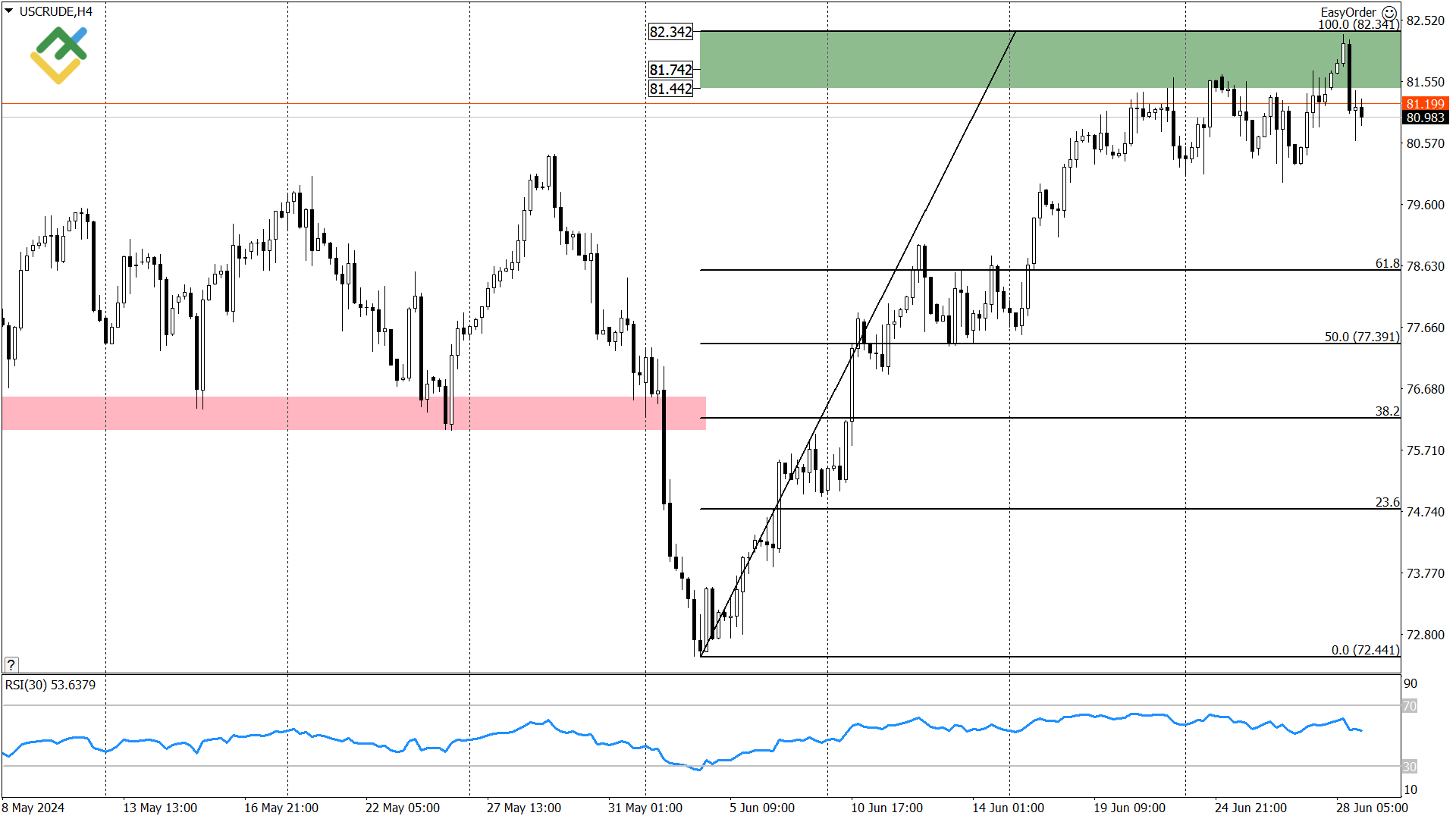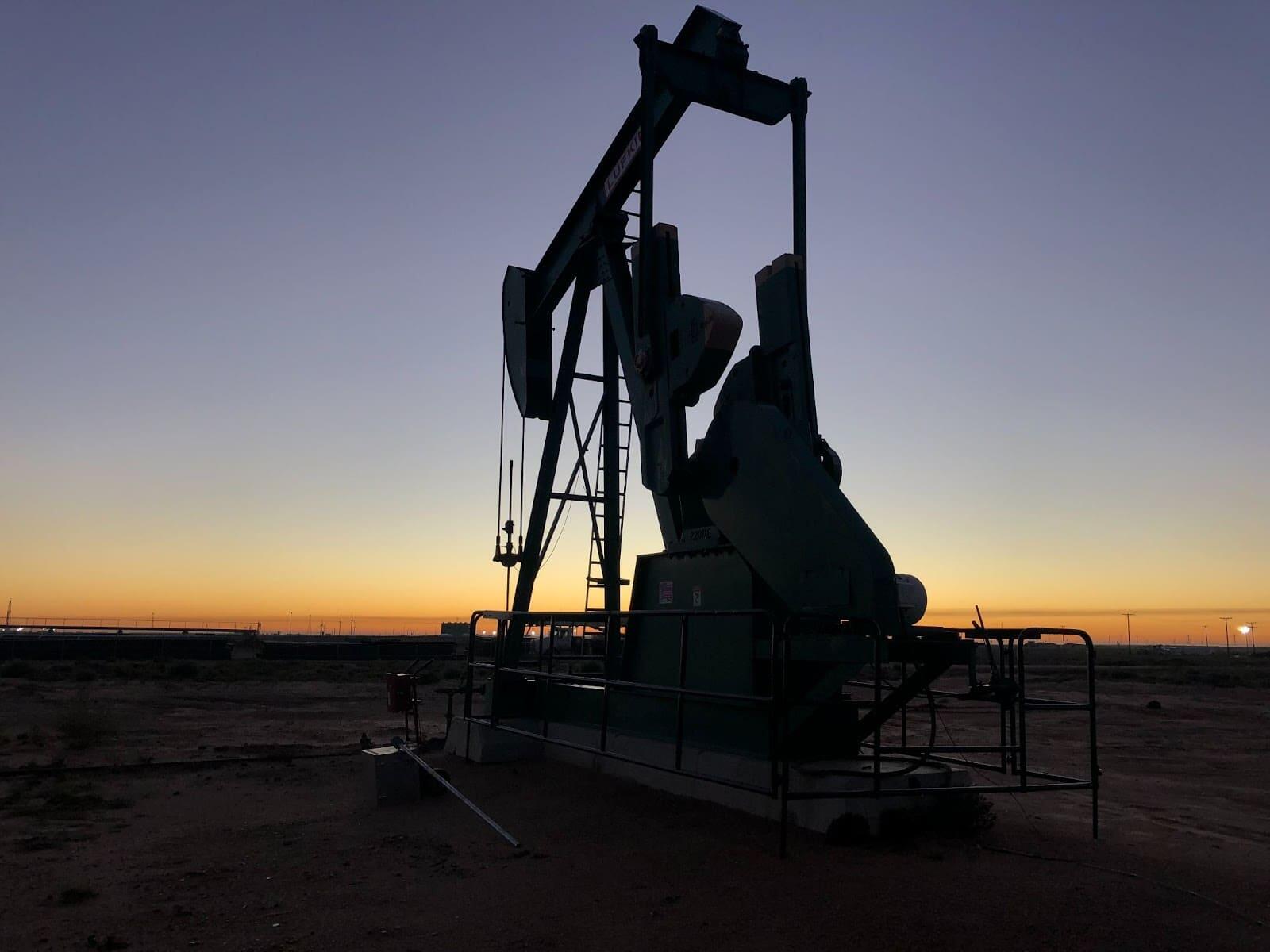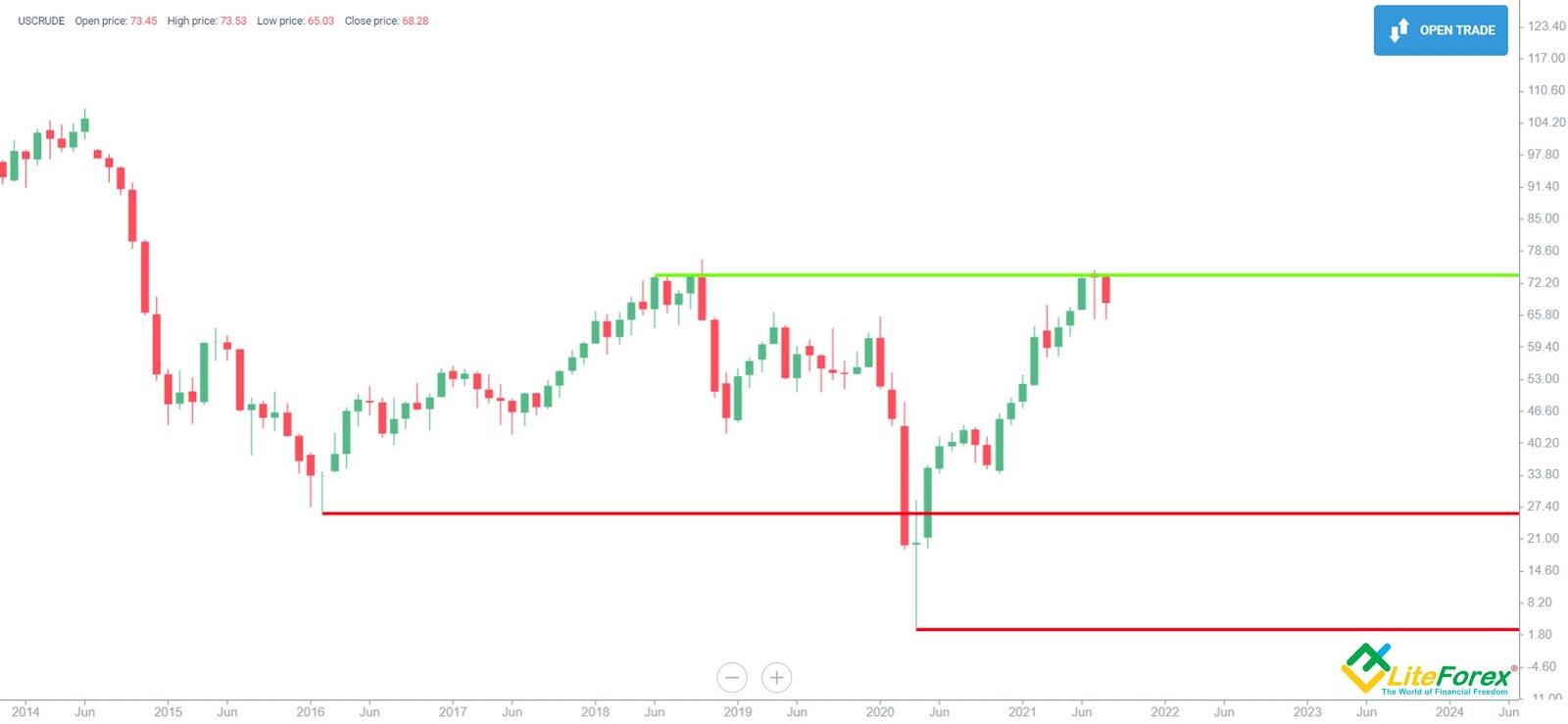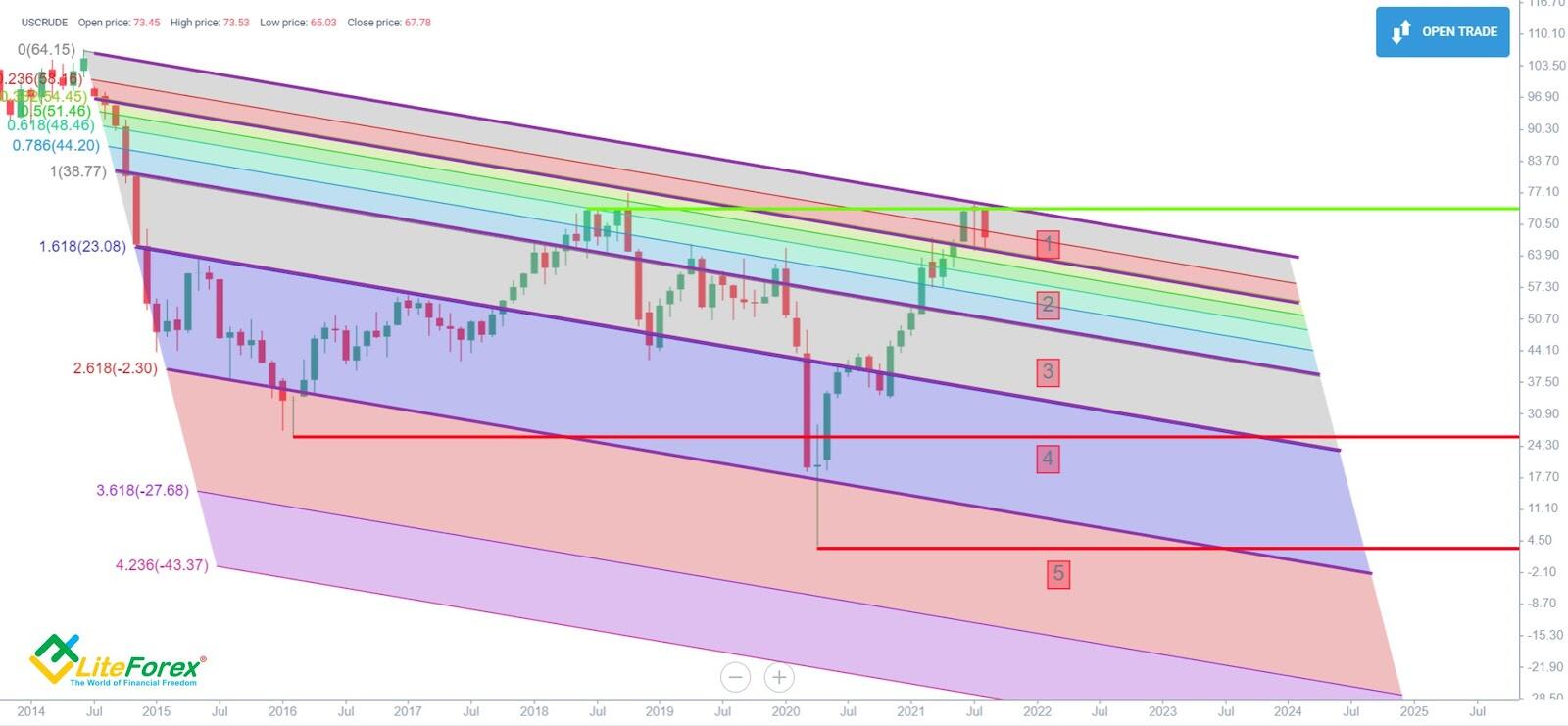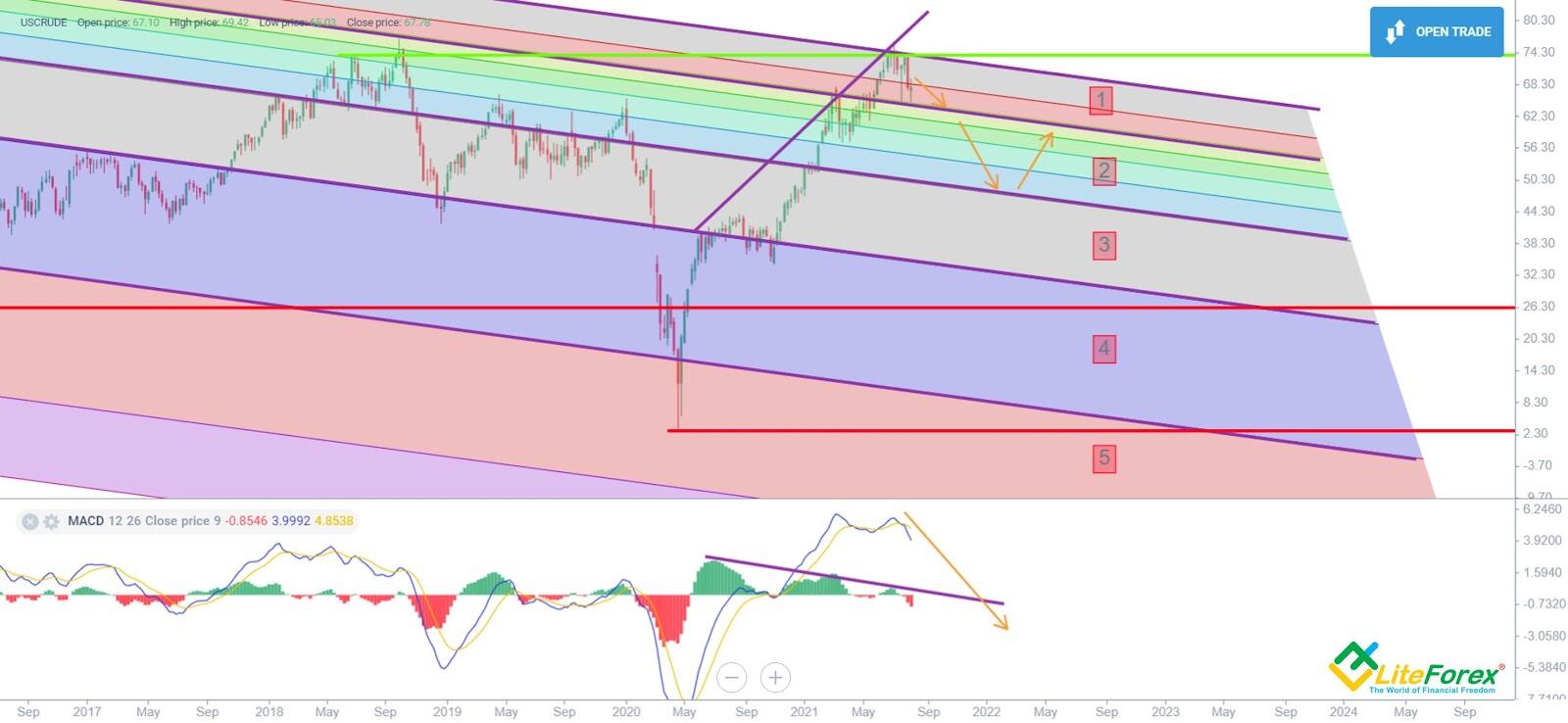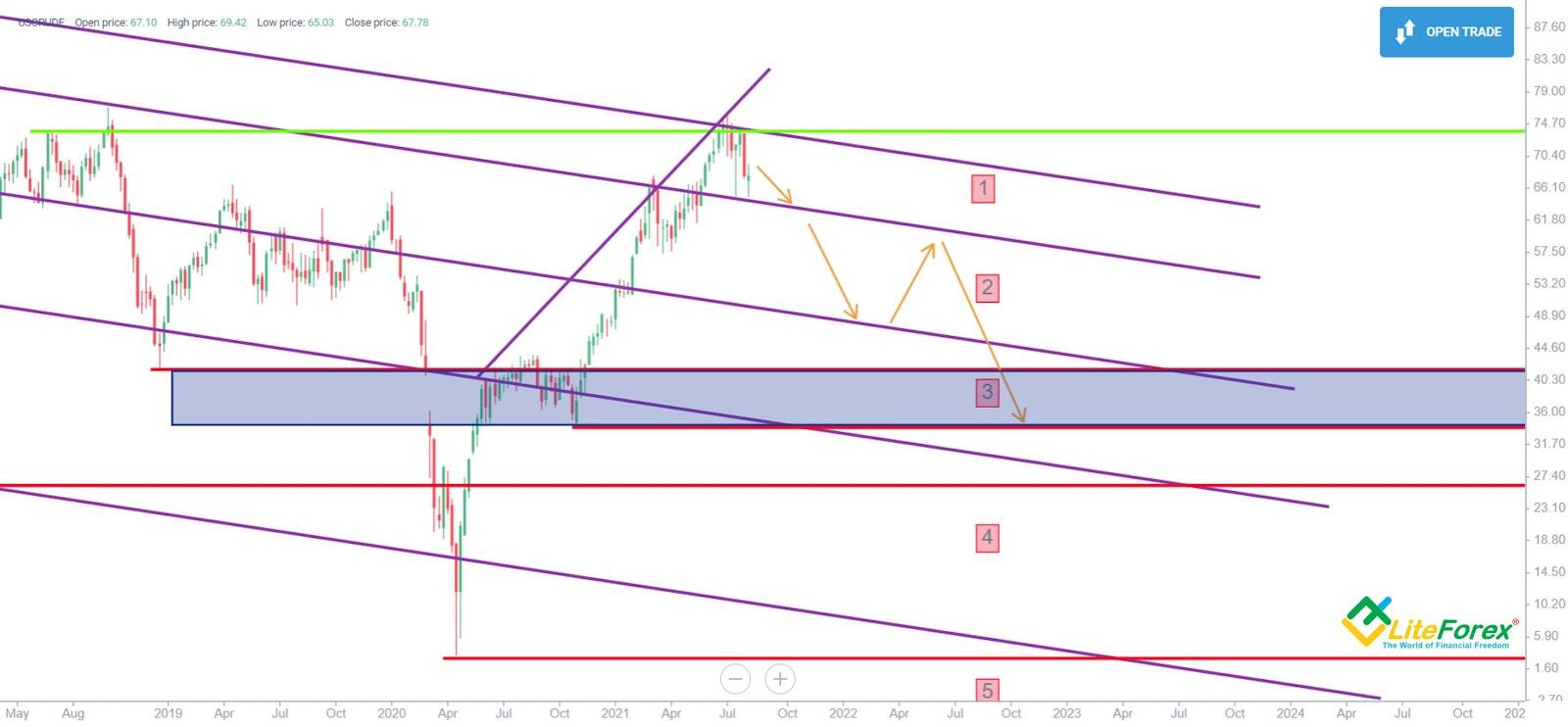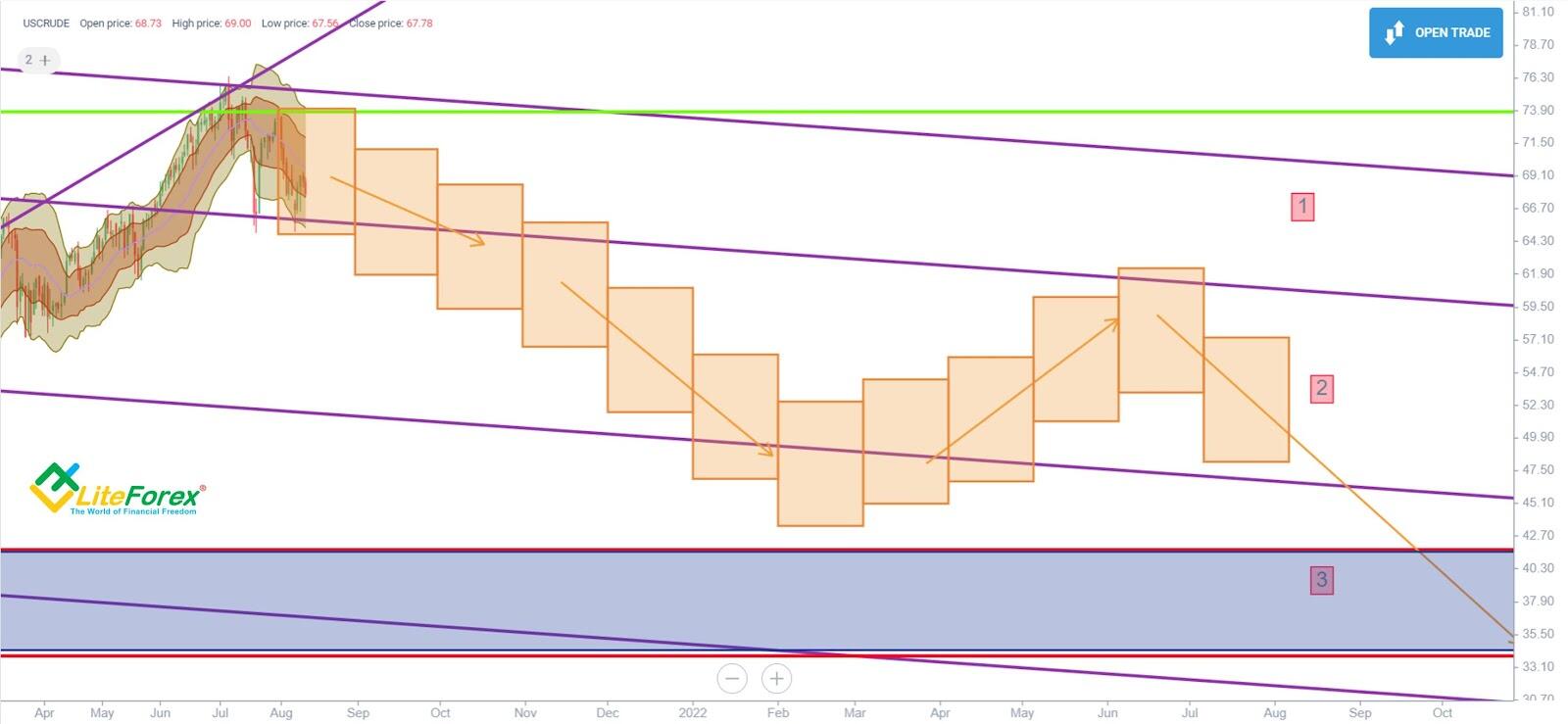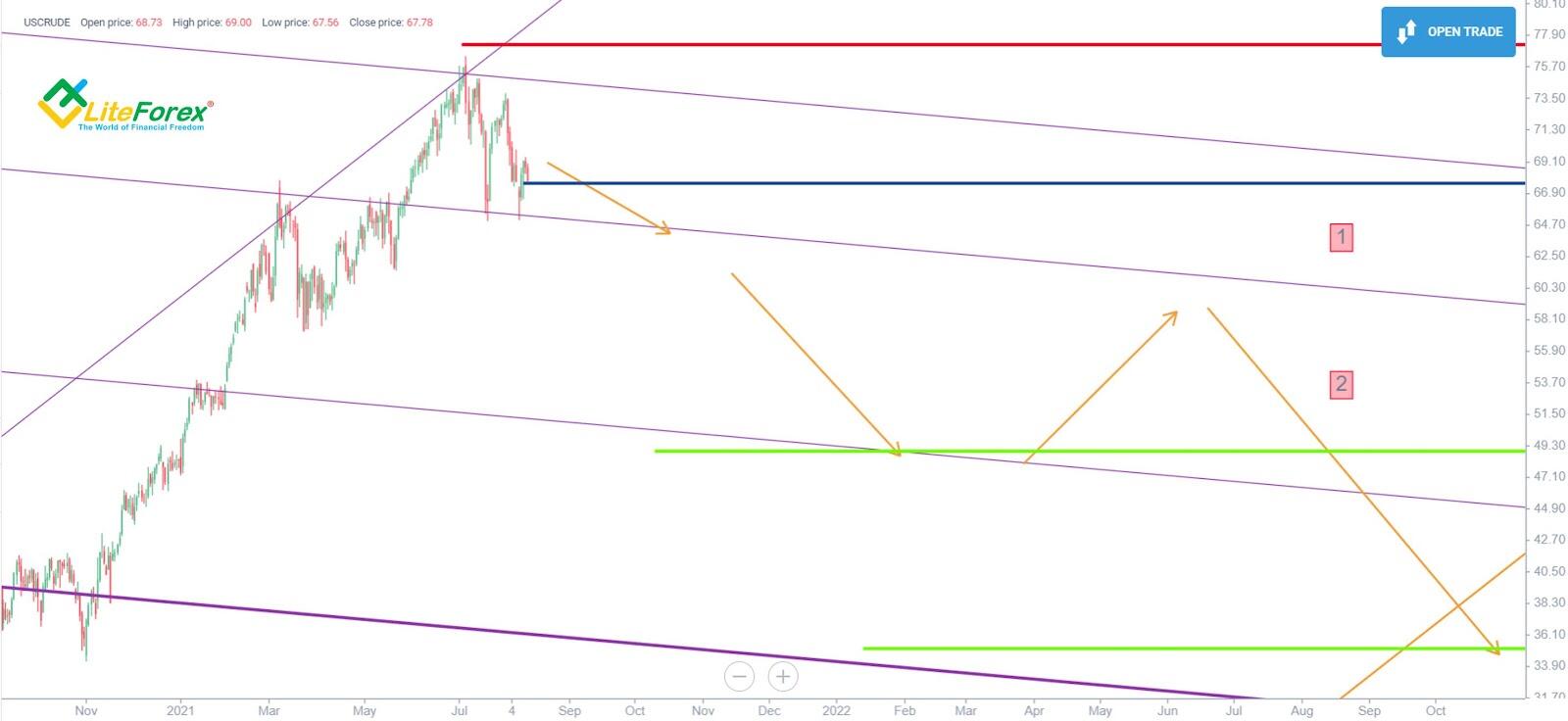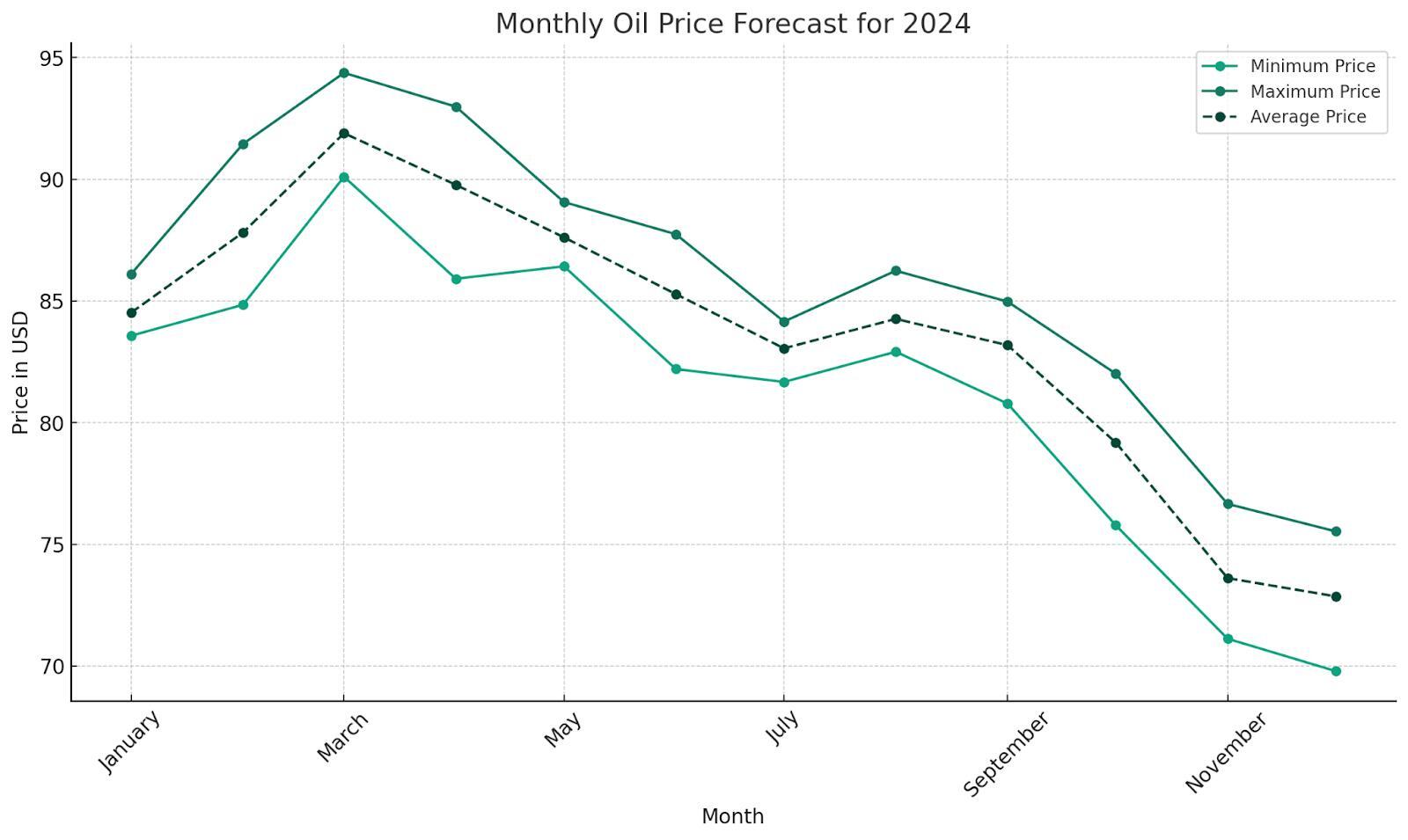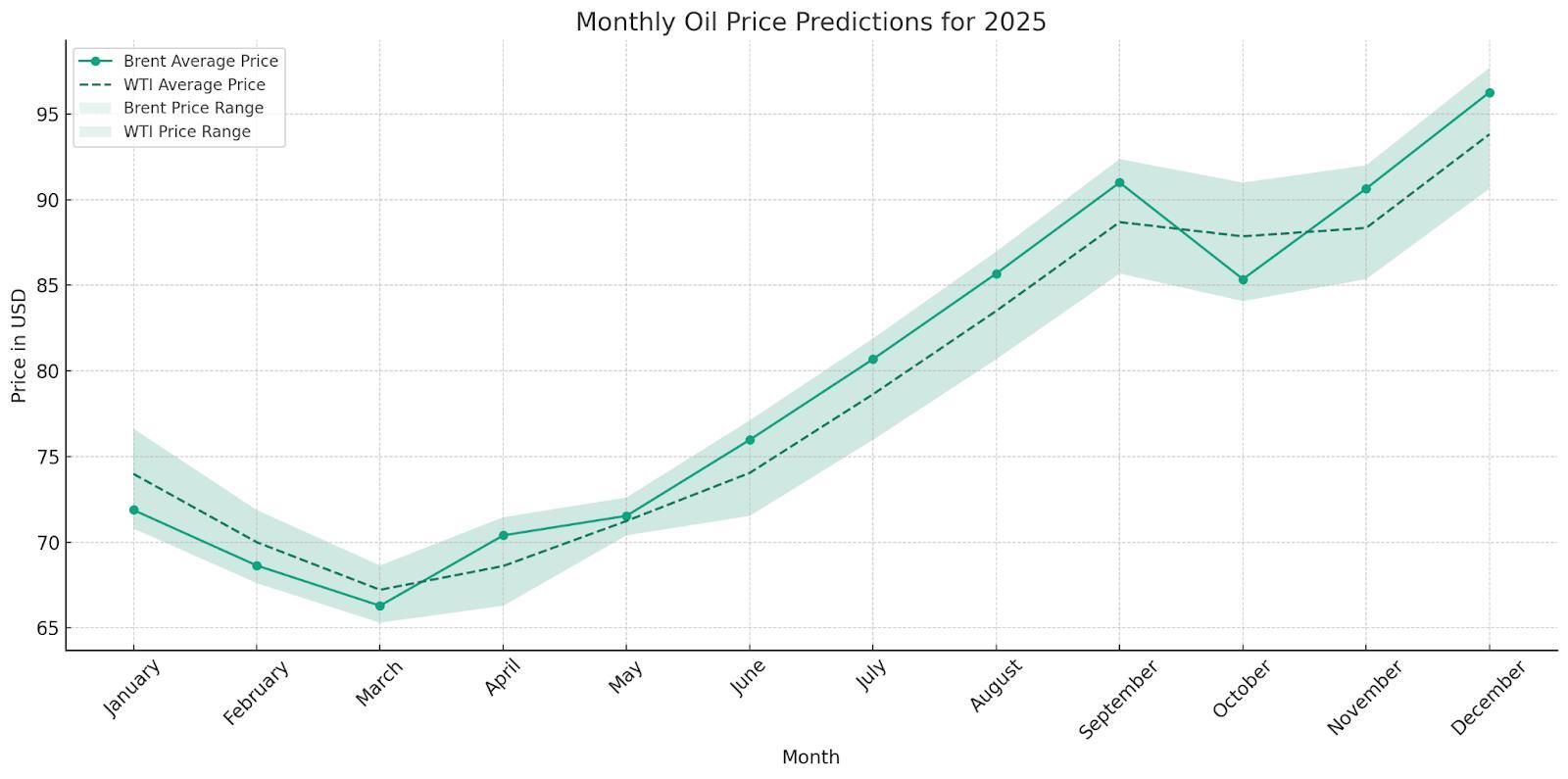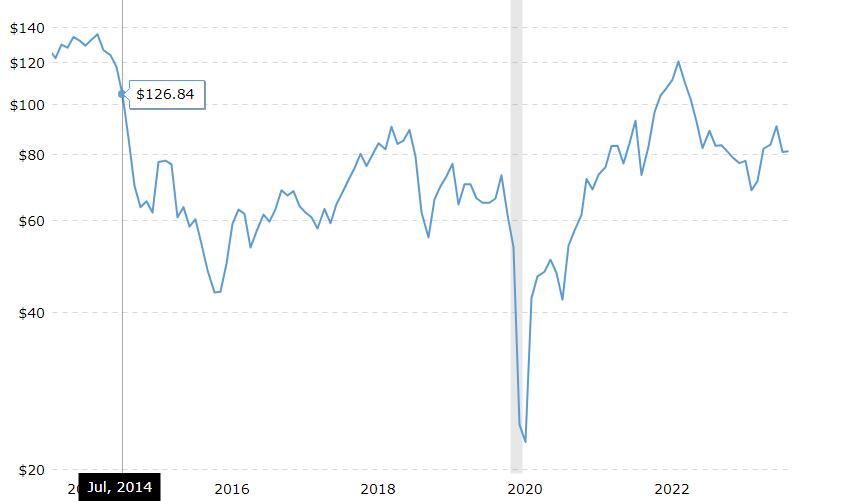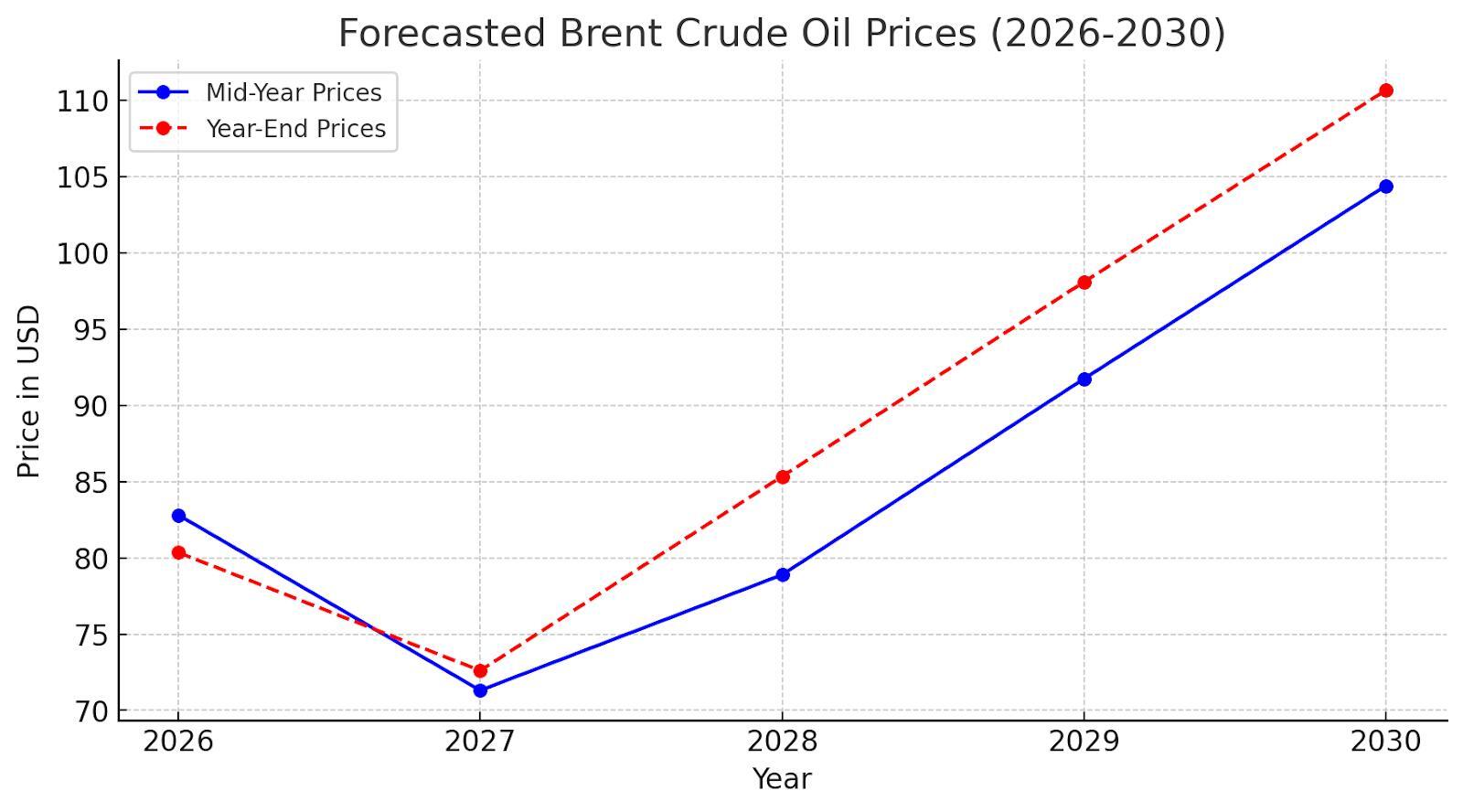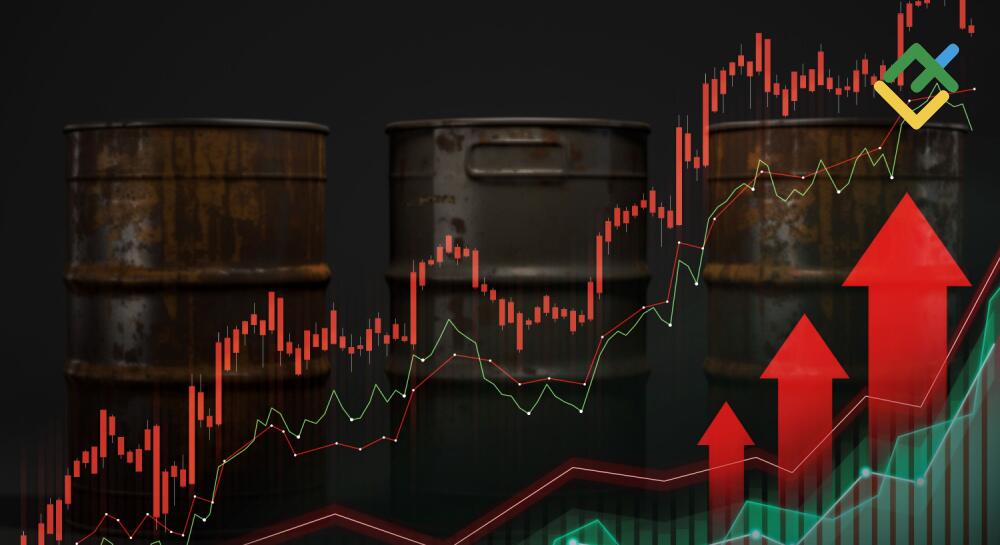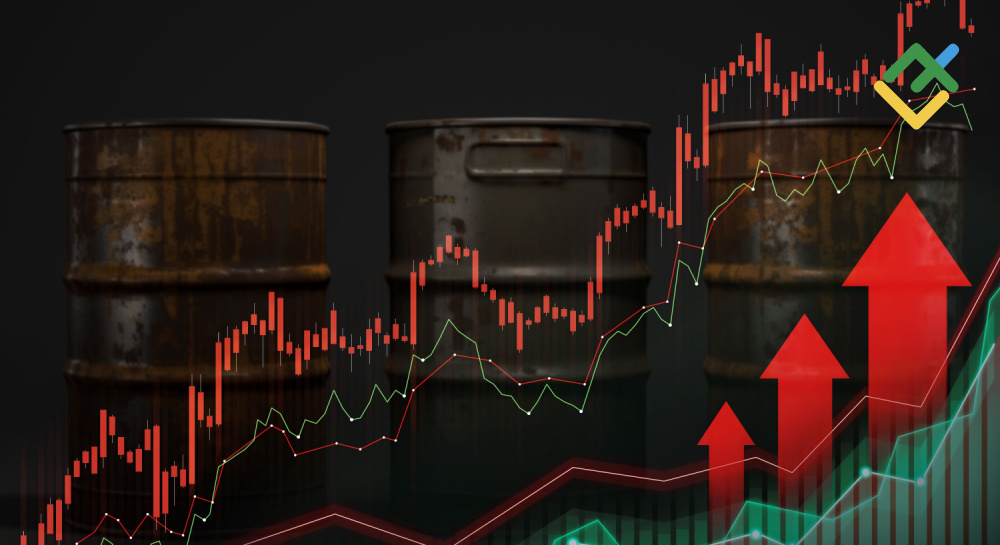
“Are oil costs expected to go up or down?” is a pertinent inquiry in the financial realm, particularly for traders and investors eyeing the energy market. The oil price forecast is a critical instrument that assists in deciphering the convoluted market dynamics. As we transition into an era where geopolitical tensions and economic uncertainties exacerbate market volatilities, a meticulous examination of the outlook is essential.
Recent data highlights a marked decline post-April 2023 after the OPEC+ production cut announcements. As documented on capital.com, this regression results from various factors, including global recession apprehensions, a high-interest rate milieu, and concerns surrounding the U.S. debt ceiling. The path of this commodity from a $130/barrel peak in March 2022, triggered by supply concerns amidst geopolitics, to a 1-year low in late 2022 illustrates its sensitivity to global cyclical swings.
The following discourse presents forecasts and analyzes many factors that could potentially affect the oil price. Read expert predictions and technical analysis in the following sections to assess the situation in the industry. This article aims to provide reliable insights that will give you a more detailed understanding of market dynamics and help you make more informed decisions.
The attempt to answer the question, “Is the value likely to go up or down?” requires a thorough analysis of historical and contemporary market data alongside a meticulous examination of the geopolitical and economic landscape. Let’s embark on an analytical expedition to try and discern the likely trends in the near and more distant future.
The article covers the following subjects:
Main takeaways: Oil Price Forecast 2023-2030
2023 Outlook. By the end of 2023, experts anticipate a price range of $70-$90 per barrel. This forecast, based on data from Capital.com, OilPrice.com, and EIA, suggests a trend toward stabilization in the face of economic headwinds that may reduce demand.
2024 Projections. Prices are expected to continue to decline in the same range next year. Market trends hint at a cautious balance between supply constraints led by OPEC’s output policies and the evolving energy landscape.
Long-term Perspective (2025-2030): Beyond 2025, the crude oil market enters a realm of greater uncertainty. As the world gradually pivots to renewable energy and electric vehicles, the traditional oil market dynamics will likely transform, potentially leading to a “new normal” with prices fluctuating between $60-$100.
Oil Price Technical Analysis
Technical analysis of the oil markets helps traders assess price trends by studying the direction of price movements and trading volumes to make informed trading decisions. To conduct technical analysis of oil charts, traders use various timeframes, instruments, indicators, and patterns.
Timeframes for Oil Analysis
The main timeframes that traders focus on when analyzing oil include short-term (hourly – H1, H4), medium-term (daily – D1), long-term (weekly – W1), and global (monthly – M1) charts. These time frames allow you to define long-term trends and short-term price movements.
Oil price technical analysis tools
- Price Charts are used to display past performance of the price and its changes visually. Candlestick charts are especially useful for oil; they display price movements more clearly.
- Technical indicators allow you to assess the direction and strength of a trend. For oil markets, moving averages (MA), relative strength index (RSI), and Stochastic are often used. We will also use these indicators in our technical analysis.
Indicators
- Moving Averages (MA) – these, a kind of dynamic levels, help traders identify trend direction and support/resistance levels. For oil instruments, the 50-day, 144-day, and 200-day moving averages are effective.
- The Relative Strength Index (RSI) shows whether an instrument is overbought/oversold, which may indicate potential trend reversals.
- Stochastic (Stochastic Oscillator) defines the current price position relative to the previous time period. It also signals the overbought and oversold zones of a given instrument at the current moment, which may also indicate possible trend reversals.
- Channel indicators show a corridor in which the price moves over a particular period. The boundaries of this corridor act as support/resistance levels, near which a price rebound may occur. The two main trading methods used here are trading a price rebound and trading a channel border breakout.
Pattern
- Chart patterns include various formations (e.g., double tops or bottoms, triangles) that can signal possible trend reversals or continuations.
- Fibonacci levels are used to identify support and resistance levels based on past price movements. The indicator displays key levels (0%, 23.6%, 38.2%, 50.0%, 61.8%, 100%) on the price chart and makes it possible to predict future movements (price often rebounds from levels).
Oil price Forecast for 3 next months
At the end of 2023, the price of WTI oil is moving in a downward trend. In the medium term, the instrument is trading below the key resistance level of 79.28 (EMA200 on the daily chart), and in the long term, the oil price is below the key resistance level of 76.06 (EMA200 on the weekly chart). Having broken out the global support level of 80.79 (EMA200 on the monthly chart) in November, the price returned to the global bear market zone.
Thus, from a technical point of view, short positions are preferable at this time.
From a fundamental point of view, experts explain the decline in oil prices by the slowdown of the world’s main economies – Chinese, American, and European. These regions account for the largest share of USCrude consumption.
Another important reason is the achievement of the limit on production reduction. However, following the OPEC+ meeting on November 30, the participating countries confirmed the June agreement to reduce oil production in 2024. Also, according to Deputy Prime Minister of the Russian Federation Alexander Novak, it was decided to reduce oil production by 700 thousand bpd further at the meeting. This means that without taking into account the extension of additional cuts, 900 thousand barrels per day less oil and petroleum products will enter the world market in the first quarter of 2024.
However, a reduction in oil production does not mean that other oil producers outside the cartel will follow suit. On the contrary, the reduction in oil production by OPEC+ creates favorable conditions for oil-producing companies in these countries, which will take advantage of the opportunity to increase production.
If a downward trend develops after breaking through the local minimum of 67.97, the nearest downside target will be 67.14.
Considering the average intra-month volatility of the WTI oil price of 700 – 1300 pips ($7 – $13), in the main scenario, it is logical to expect the instrument in the zone of $50 – $40 within three months. It is worth noting that the minimum of the last wave of corrective growth (from early November 2020 to early June 2022) is near $36.41.
Technical indicators, RSI and Stochastic, in the weekly and monthly price charts are in the zone of short positions.
In an alternative scenario, the price will not fall below the support of $68.92 (Fibonacci level 61.8%). This is possible if the cycles of monetary restriction by the Fed and other major central banks in the world are completed. This scenario is also supported by the positive forecasts of economists regarding global economic growth in 2024 and the weakening of the US dollar.
Not long ago, the price already tried to break out this support level twice and bounced from it twice. At the moment, the buyers are trying to consolidate the instrument in the short-term bullish trend zone – above the resistance level of $71.65 (EMA200 in the hourly chart).
In case of price further growth, a breakout of the key resistance level of $76.10 (EMA200 in the weekly chart) will take the price into the long-term bull market zone, and a breakout of the resistance level of $80.80 (EMA200 in the monthly chart) will confirm the global uptrend.
If an alternative scenario is implemented, the price of WTI oil could reach $90.00 per barrel by early April 2024.
Long-term US Crude Analysis for 2024
Long-term technical analysis involves analyzing price charts in weekly (Week) and monthly (Month) timeframes.
As we noted in the previous section, at the moment (end of 2023), the price of WTI oil is moving in the bear market zone.
At the same time, the technical indicators RSI and Stochastic in the weekly and monthly price charts are in the zone of short positions.
Having returned below the level of $78.85 (Fibonacci level of 50.0% of corrective growth from early November 2020 to early June 2022), the price also completed an upward correction. Consequently, the global downtrend has resumed. A confirmation signal is a breakout of the support level of $68.90 (Fibonacci level 61.8%) and the price consolidating below.
From the point of view of technical analysis, from the annual perspective, we can expect a price drop to around $35 – $25 per barrel.
In an alternative scenario, the price will not break out the support level of $68.90 and will again return to the long-term bull market zone, above the key resistance level of 80.80 (EMA200 in the monthly chart).
If this scenario develops after breaking out the resistance levels of $88.90 (Fibonacci level 38.2%) and $93.00 (local resistance level), the price will head to the upper border of the ascending channel in the weekly chart, passing near the levels of $101.30 (Fibonacci level 23.6%) and $102.00.
A bolder forecast for an alternative scenario suggests an increase in price to the balance line for the first half of 2024, around $109.00.
Thus, in the main scenario, we expect a further decline in the price toward the support of $36.41. From a technical point of view, short positions are preferable at the moment. To confirm the scenario, one should wait for the breakout of level $68.90.
Expected oil prices in the main scenario
| Month | Price forecasts for US CRUDE | |
|---|---|---|
| Low, $ | High, $ | |
| January 2024 | 70 | 65 |
| February 2024 | 67 | 62 |
| March 2024 | 65 | 60 |
| April 2024 | 50 | 45 |
| May 2024 | 47 | 42 |
| June 2024 | 45 | 40 |
| July 2024 | 42 | 37 |
| August 2024 | 40 | 35 |
| September 2024 | 37 | 32 |
| October 2024 | 35 | 30 |
| November 2024 | 32 | 27 |
| December 2024 | 30 | 25 |
Expected oil prices in an alternative scenario
| Month | Price forecasts for US CRUDE | |
|---|---|---|
| Low, $ | High, $ | |
| January 2024 | 73 | 75 |
| February 2024 | 75 | 77 |
| March 2024 | 77 | 79 |
| April 2024 | 80 | 85 |
| May 2024 | 83 | 88 |
| June 2024 | 86 | 91 |
| July 2024 | 90 | 95 |
| August 2024 | 93 | 98 |
| September 2024 | 96 | 101 |
| October 2024 | 99 | 104 |
| November 2024 | 102 | 107 |
| December 2024 | 105 | 110 |
Long-term trading plan for WTI Crude
Based on the above arguments and technical analysis, let us make up a trading plan for the next three months and a year.
Primary scenario
Expect a breakout of level $68.90 (Fibonacci level 61.8%) and local support levels of $64.60 and $64.00. The earliest signal could be a breakout of the short-term support level of $71.65 (EMA200 in the hourly chart) and the recent local low of 70.64.
- Aggressively: Sell Stop $70.50. Stop-Loss $73.15.
- Moderately: Sell Stop $67.85. Stop-Loss $74.15.
- Targets (3 months): $65.00, $64.00, $60.00, $56.00, $50.00, $46.00, $40.00.
- Targets (1 year): $37.00, $36.00.
Alternative scenario
The earliest signal here could be a breakout of local resistance levels $73.00 and $74.00.
- Aggressively: Buy Stop $73.15. Stop-Loss $70.50.
- Moderately: Buy Stop $74.15. Stop-Loss $67.85.
- Targets (3 months): $76.00, $76.10, $78.00, $78.85, $79.00, $79.30, $80.00, $80.80, $83.00, $85.00, $88.00, $90.00, $92.00, $93.00.
- Targets (1 year): $95.00, $100.00, $101.00, $101.30, $109.00, $110.00.
The targets above correspond to support/resistance levels. This does not mean that they will necessarily be achieved, but they can serve as a guide when building trading strategies.
Get access to a demo account on an easy-to-use Forex platform without registration
Our blog provides daily short-term oil forecasts and trading signals based on technical analyses and margin zones.
Oil weekly price forecast as of 01.07.2024
The oil price has reached the key resistance in the medium-term downtrend at 82.34 – 81.44. Last week, the asset failed to break through this zone. Bears managed to hold the price below this area. In this connection, this week, consider short trades with the first target at 77.39 and the second target at 72.44. If the asset breaches the level of 72.44, the price will likely reach the Target Zone 71.27 – 70.74.
The asset should break through the 82.34 level to allow traders to open long trades and reverse the downtrend. In this case, the nearest bullish target will be the 84.90 – 84.31 area. After that, one should identify new supports for short trades.
USCrude trading ideas for the week:
Sell according to the pattern at resistance (B) 82.34 – 81.44. TakeProfit: 77.39, 72.44. StopLoss: according to pattern rules.
Technical analysis based on margin zones methodology is presented by an independent analyst, Alex Rodionov.
Start trading with a trustworthy broker
Oil Price Prediction for 2023 by Experts
As we approach 2024, predicting the market value becomes a key focus for investors, reflecting the complex interplay between global geopolitics and economic dynamics. A spectrum of expectations regarding its value is presented by various analysts. This section meticulously explores projections from reputable sources, including Capital.com, OilPrice.com, and the U.S. Energy Information Administration (EIA). Each projection, rooted in nuanced market analysis, unveils a narrative that could guide stakeholders through the uncertain waters of the market. The aim is to foster a deeper understanding of the market’s potential trajectory, aiding informed decision-making amidst evolving market conditions.
Capital.com
Based on a meticulous examination conducted by the Dutch bank’s ING, the oil value prediction by Capital.com manifests a mixed bag of expectations. The oil value will be $89 per barrel in 2024. A slight decrease is expected в 2025 when the black stuff rate will fall to $75 per barrel.
This trajectory insinuates a bearish sentiment prevailing in the market, potentially orchestrated by global economic headwinds. While shedding light on the preliminary dynamism of the market, the forecast emphasizes the importance of vigilance when trading. The oil decline from 2024 to 2025 signals a market readjustment that warrants close observation for investors and policy-makers alike.
OilPrice.com
The analytics from a Reuters poll showcased on OilPrice.com unveil a relatively bullish stance. The narrative propels Brent to an average of $86.45 per barrel, while its counterpart, WTI Crude, is expected to hover around $82.99 per barrel in 2024. This trend underscores a market-tightening ambiance driven largely by global demand and supply dynamics.
The elevated predictions, as compared to preceding estimations, delineate a market sentiment gravitating towards optimism. Delineating these value averages furnishes a foundational blueprint for investors and market strategists in anticipating the market’s pulse and aligning their strategies accordingly.
EIA
The U.S. Energy Information Administration (EIA) unveils a climb in Brent crude prices to the mid-$80 range in the second half of 2024, a significant ascent from the June 2023 average of $75 per barrel.
Correspondingly, the WTI value is anticipated to emulate this trend, albeit at a $5 discount to Brent. This projection, rooted in an anticipated demand surge, orchestrates a bullish rhythm in the market. The prognosis not only highlights the demand-supply dynamics but also furnishes a vantage point for investors to calibrate their market strategies. The latest prediction from EIA emboldens a narrative of cautious optimism amidst a milieu of market uncertainties.
| Month | Minimum | Maximum | Average |
|---|---|---|---|
| October 2023 | 80.81 | 88.37 | 84.59 |
| November 2023 | 86.00 | 90.00 | 88.00 |
| December 2023 | 90 | 95.00 | 82.25 |
Source: tradingeconomics.com
US Crude Oil Technical Analysis
Source: macrotrends.net
I always do a technical analysis of at least three time frames to make a realistic oil forecast. First, we’ll analyze the US Crude price movements on the monthly chart.
The chart above provides the WTI oil market‘s 2013–2021 price history.
A strong resistance level of 73.80 USD was formed in June 2018. The US Crude value has come close to that level, but buyers have failed to settle above it so far. If sellers win, the nearest support level will be around 26.20 USD.
On the whole, the chart points to a descending potential of the US Crude price.
Now, let’s switch to Fibonacci ratios. The US Crude price chart above displays five areas outlined for a bearish trend according to Fibo ratios. Each of the areas features a specific price pattern:
- Area 1 – a trend base. The price’s return to this area will indicate a possible change in the price direction.
- Area 2 and 3 – consolidation areas. The price is highly likely to get stuck in those areas for a long time.
- Area 4 – trend development area characterized by high market volatility.
- Area 5 – area of peak values.
A trend may have numerous consolidation and trend development areas, but only one area 1 and 5.
WTI Crude Forecast For Next Three Months
The price is in the first area, testing the trend’s limit. A breakout will point to a possible change in the oil market’s trend, and the whole bearish formation may be canceled.
The resistance level of 73.80 USD mentioned above hinders the further growth of WTI oil as well. The price looks stuck within the limits of the first area, and a breakout upside looks hardly possible.
The price will most likely consolidate in a narrow range of 65–74 USD and then move into a downward range of area 2. At least it will be held up there until the end of the year.
The MACD confirms the bearish correction, too. The chart above shows a cascade of the histogram’s divergences with the price chart. At the same time, the MACD’s moving averages show a bearish crossover for the second time and are directed down.
That’s a clear bearish signal for a weekly TF chart. So, based on the Fibonacci ratios, we can presume the bearish potential of oil is at around 50 US dollars.
Long-Term US Crude Analysis for 2024
The analysis of price history over the past years shows a strong support area in the range of 42.10 – 34.25 USD. A more realistic forecast suggests a price move to consolidation area 3 in the long term. A future price might reach the buyers’ blue area in the chart.
Will the oil price’s projected fall stop afterward? It’s hard to say for now, as everything will depend on the buyers’ reaction to the level of 35 USD. If bulls fail to resist a bearish attack, the price may sink to the historical low of 34.1 USD. Towards the end of the next year, we’ll understand whether or not such a fall is possible.
I used Bollinger bands to calculate the US Crude (WTI) expected trading range.
The result is displayed in the chart above and the table below.
| Month | US CRUDE price | |
|---|---|---|
| Minimum | Maximum | |
| August 2021 | 65.00 | 73.53 |
| September 2021 | 61.90 | 71.00 |
| October 2021 | 59.30 | 68.50 |
| November 2021 | 56.65 | 65.75 |
| December 2021 | 51.80 | 60.85 |
| January 2022 | 46.85 | 56.05 |
| February 2022 | 43.45 | 52.60 |
| March 2022 | 45.10 | 54.30 |
| April 2022 | 46.80 | 55.90 |
| May 2022 | 51.20 | 60.20 |
| June 2022 | 53.25 | 62.30 |
| July 2022 | 48.15 | 57.35 |
Long-term trading plan for WTI Crude
Let’s finalize our technical analysis of US CRUDE.
The key levels are marked in the chart above. Short positions appear to be quite relevant as the projected price may drop to 35 USD within one or two years.
They can be opened at the current level at around 67 USD. Stop Loss should be placed above the latest high of 77 USD.
Profits can be fixed at two targets. A short-term target is around 49 USD. More patient bears might be lucky to close at approximately 35 USD.
You can also close 50% of your position at the first target and then fix the rest at 35 USD. Observing your risk management rules is very important. Avoid losses exceeding 1% of your deposit!
Oil Price Predictions for 2024
The tables below encapsulate a meticulous prediction for 2024, broken down monthly. Sourced from longforecast.com, they delineate the minimum, maximum, and average values for both WTI and Brent. This data is instrumental for stakeholders in gauging the market’s trajectory, aiding informed decision-making. While some figures are calculated averages, they provide a comprehensive glimpse into the anticipated cost movements, crucial for strategic planning in the volatile market.
For Brent:
| Month | Minimum (USD) | Maximum (USD) | Average (USD) |
|---|---|---|---|
| January | 83.57 | 86.11 | 84.52 |
| February | 84.84 | 91.45 | 87.81 |
| March | 90.10 | 94.37 | 91.89 |
| April | 85.91 | 92.98 | 89.77 |
| May | 86.42 | 89.06 | 87.61 |
| June | 82.20 | 87.74 | 85.28 |
| July | 81.67 | 84.15 | 83.05 |
| August | 82.91 | 86.24 | 84.26 |
| September | 80.78 | 84.97 | 83.18 |
| October | 75.78 | 82.01 | 79.18 |
| November | 71.12 | 76.66 | 73.61 |
| December | 69.79 | 75.53 | 72.86 |
Source: tradingeconomics.com
For WTI:
| Month | Minimum (USD) | Maximum (USD) | Average (USD) |
|---|---|---|---|
| January | 83.84 | 87.00 | 85.42 |
| February | 85.71 | 92.39 | 89.05 |
| March | 91.02 | 96.32 | 93.67 |
| April | 87.68 | 94.90 | 91.29 |
| May | 88.76 | 91.46 | 90.11 |
| June | 87.44 | 90.11 | 88.77 |
| July | 85.02 | 88.77 | 86.89 |
| August | 83.45 | 86.31 | 84.88 |
| September | 83.47 | 86.01 | 84.74 |
| October | 78.30 | 84.74 | 81.52 |
| November | 79.49 | 85.69 | 82.59 |
| December | 78.00 | 84.42 | 81.21 |
Source: tradingeconomics.com
IEA and OPEC
The IEA anticipates a deceleration in demand growth to 880,000 barrels per day (bpd) from an earlier projection of one million barrels per day due to factors like harsher global economic conditions and advances in energy efficiency. Conversely, OPEC predicts a rise in demand by 2.25 million bpd in the same year, with an optimistic view of robust economic growth, especially in China.
The substantial discrepancy between these two projections, equivalent to over 1% of global daily use, reflects opposing perceptions of the future market and could imply varied quote predictions, although specific quotes are not provided in the original text. Both entities, however, demonstrate a closer alignment in their demand growth, predicting 12 months, with the IEA and OPEC predicting 2.3 million bpd and 2.44 million bpd, respectively.
JP Morgan
On June 14, JPMorgan adjusted its forecasts for the current year and 2024, attributing the revision to an anticipated increase in global supply that would counterbalance an unprecedented surge in demand and a buildup of inventory, consequently mitigating the likelihood of value spikes.
The financial giant scaled back its Brent projection for 2023 from $90 to $81 per barrel and, similarly, curtailed its West Texas Intermediate (WTI) expectation from $84 to $76 per barrel. More notably, for 2024, JPMorgan lowered its expectations for Brent crude to $83 per barrel, a substantial reduction from its earlier prediction of $98, and for WTI, the estimation was revised downward to $79 a barrel from the previously anticipated $94. This notable recalibration in cost expectations emanates from a strategic analysis considering multifaceted supply and demand dynamics in the global market.
Oil Price Predictions for 2025
The tables delineate the anticipated market trends for Brent and WTI through 2025, on a monthly basis. Sourced from a Long Forecast, these projections unveil a potential pricing trajectory crucial for market stakeholders. The data encapsulates minimum, maximum, and average costs, providing a comprehensive guide for financial analysis and strategic planning in navigating the volatile market landscape.
Brent:
| Month | Minimum (USD) | Maximum (USD) | Average (USD) |
|---|---|---|---|
| January | 70.80 | 76.63 | 71.88 |
| February | 67.61 | 71.88 | 68.64 |
| March | 65.30 | 68.64 | 66.29 |
| April | 66.29 | 71.46 | 70.40 |
| May | 70.40 | 72.61 | 71.54 |
| June | 71.54 | 77.12 | 75.98 |
| July | 75.98 | 81.90 | 80.69 |
| August | 80.69 | 86.98 | 85.69 |
| September | 85.69 | 92.37 | 91.00 |
| October | 84.08 | 91.00 | 85.36 |
| November | 85.36 | 92.01 | 90.65 |
| December | 90.65 | 97.71 | 96.27 |
Source: longforecast.com
WTI:
| Month | Minimum (USD) | Maximum (USD) | Average (USD) |
|---|---|---|---|
| January | 70.80 | 76.63 | 73.99 |
| February | 67.61 | 71.88 | 70.00 |
| March | 65.30 | 68.64 | 67.22 |
| April | 66.29 | 71.46 | 68.61 |
| May | 70.40 | 72.61 | 71.24 |
| June | 71.54 | 77.12 | 74.05 |
| July | 75.98 | 81.90 | 78.64 |
| August | 80.69 | 86.98 | 83.51 |
| September | 85.69 | 92.37 | 88.69 |
| October | 84.08 | 91.00 | 87.86 |
| November | 85.36 | 92.01 | 88.35 |
| December | 90.65 | 97.71 | 93.82 |
Source: longforecast.com
Oil Price Prediction from BMI
According to a recent report from BMI, a Fitch Solutions subsidiary, Brent’s average price will be around $80 in the current year, $83 in both 2024 and 2025, and $80 for 2026 and 2027. Interestingly, a Bloomberg Consensus mentioned within the report anticipated a slightly different trajectory, projecting Brent to average $81 in 2023, $83 in 2024, somewhat retreating to $81 in 2025, further declining to $78 in 2026, and $70 in 2027.
Oil Price Predictions from JP Morgan
JPMorgan, expecting a potentially turbulent supercycle in the market, predicts that Brent crude will range between $90 and $110 in 2024 and elevate to $100 and $120 in 2025 amidst global supply apprehensions and recent production cuts from crucial producers like OPEC and Russia. Despite projecting an eventual stabilization around $80 in a broader perspective, there is an acknowledged risk of value settling around $100 per barrel.
The financial institution anticipates a supply-demand imbalance, with a 1.1 million barrel per day deficit in 2025, which is expected to widen significantly by 2030.
Oil Price History
This journey is a tale of supply and demand dynamics, geopolitical tensions, and global economic health. Tracing back to the 1980s, the average closing cost underwent a significant oscillation, mirroring the world’s economic and political climate. The price per barrel (bbl) saw a modest amount of $15.97 in 1988, reflecting a period of relative calm in the markets.
Fast forward to the 2000s, the advent of industrialization in emerging markets like China and India spurred a surge in demand, propelling the average to $30.38/bbl in 2000 and further to $99.67/bbl in 2008. However, the global financial crisis of 2008 led to a plummet in cost to $44.60/bbl by the end of the year.
The subsequent recovery and geopolitical tensions in relevant regions drove value upwards, with 2011 seeing an average of $94.88/bbl. The dynamics continued with the advent of shale oil production in the U.S., going costs down to an average of $48.66/bbl in 2015. The saga continued with OPEC’s production adjustments and global demand fluctuations, reflecting a cost of $94.53/bbl in 2022 before settling at an average of $77.59/bbl in 2023.
The market narrative of recent times is one of volatility and global economic interplay. In 2023, the value of WTI hovered below $83 per barrel due to concerns about a weakening global demand despite tight supply worries. On June 26, 2023, Brent was assessed at $74.35/bbl, whereas WTI was at $69.37/bbl, indicating a variation among different grades of crude3.
In September 2023, a new height was reached, with the WTI touching $85 per barrel, marking a significant milestone for the year. However, this euphoria was short-lived as projections from the U.S. Energy Information Administration (EIA) predicted a fall in 2023 and 2024, with an average of $83/bbl in 2023 and $78/bbl in 2024, primarily due to an anticipated outpacing of global production overconsumption.
Long-Term Oil Predictions 2026-2030
The outlook from 2026 to 2030 is entangled in a web of multiple global factors, including supply and demand dynamics, geopolitical tensions, and the pace of transition towards renewable energy. Several predictions have been made by different organizations regarding the trajectory during this period.
According to an assessment from Dutch bank ING, they judiciously modified its predictions for Brent crude, foreseeing its value gently oscillating at $82 in 2023 and subsequently elevating to $99, with a poised average of $90, as reported by Capital.com.
Meanwhile, the U.S. Energy Information Administration (EIA) and ANZ Research each issued separate forecasts, anticipating Brent crude to meander through varied fiscal landscapes in the years stretching towards 2024. Notably, Fitch Solutions uniquely offered projections plunging to a meek $53 by 2026, yet a palpable void persists, with no financial seers furnishing predictions reaching into the distant horizon of 2030.
However, there’s an alternative view presented by Investorplace, which cites the EIA’s projection of Brent reaching $89 per barrel by 2030. This figure represents a more optimistic outlook compared to the prediction by Capital.com.
On the other hand, a consultancy report mentioned by Reuters suggests a bearish scenario where global costs could drop to around $40 a barrel by 2030 if governments worldwide push to reduce fuel consumption in line with U.N.-backed plans to limit global warming.
Moreover, a bold projection by the International Energy Agency (IEA) suggests a significant drop in global demand by 100 million barrels daily to about 77 million by 2030. This assessment, if actualized, could potentially lead to a regime that cuts oil prices for crude oil if supply remains constant or increases.
| Year | Mid-Year | Year-End | Tod/End,% |
|---|---|---|---|
| 2026 | $82.81 | $80.35 | -4% |
| 2027 | $71.31 | $72.61 | -13% |
| 2028 | $78.89 | $85.34 | +2% |
| 2029 | $91.74 | $98.09 | +17% |
| 2030 | $104.40 | $110.66 | +32% |
Factors that Can Affect the Oil Price
The oil price narrative is a tapestry of multiple intertwined factors. Top on the list is the geopolitics of supplier regions. Any unrest or political instability in these regions can cause significant swings. Similarly, decisions by major producing countries and organizations like OPEC regarding production levels directly impact supply and, subsequently, pricing.
Global economic health is another major player. Economic booms drive up demand for energy, pushing value upwards, while recessions dampen demand, leading to cuts in cost. Furthermore, technological advancements in extraction and production, like fracking, also affect supply levels and prices.
Additionally, the global drive towards renewable energy and subsequent policies and regulations can influence the demand. The pace at which renewable energy substitutes fossil fuels in various sectors will significantly affect pricing in the long run.
Why Oil?
Dubbed as ‘black gold,’ it remains a pivotal commodity in the global economic engine. Its intrinsic value stems from its multifaceted utility. Oil is used to fuel transportation and heat homes. It is also an essential raw material in numerous industries. This ubiquitous demand makes it a key player in the global energy scene.
Moreover, its market volatility often mirrors global economic and political scenarios, making it a significant indicator and, sometimes, a driver of global economic health. For investors, black gold presents an avenue for portfolio diversification, offering a hedge against inflation during turbulent times.
Oil Varieties
In the realm of financial markets, two prominent types are traded: the highly favored American WTI and its counterpart, British Brent.
West Texas Intermediate (WTI)
WTI is a staple in U.S. refineries, serving as a crucial value benchmark. It’s a light sort with high API density and minimal sulfur content, indicating its density relative to water. WTI is traded extensively among firms and investors, primarily through futures via CME Group, with Light Sweet Crude Oil (CL) future being a globally traded future.
Cushing, Oklahoma, is the principal storage hub for WTI, linking to pipelines that distribute the commodity nationwide. WTI serves as a vital feedstock for refineries in the Midwest and Gulf Coast regions.
Brent Crude Oil
Brent, originating from the North Sea’s Brent field, is a major petroleum rate oil benchmark for Europe, Africa, and the Middle East. Despite most platforms in its originating field being decommissioned, Brent’s quote often surpasses WTI’s, sometimes by over $10, due to various market factors, including supply, demand, and storage costs.
Shale Oil Impact
The shale boom irked OPEC, viewing it as a market threat. In retaliation, OPEC increased production, plummeting quotes to below $30 per barrel in early 2016, aiming to oust shale producers. However, this backfired, slashing OPEC’s revenue while shale producers adapted, reducing costs and remaining profitable even at lower costs.
OPEC’s Role
With stable demand predicted, the surge in U.S. shale production poses a challenge. Initiated by high estimates in 2014, the shale revolution thrived despite high production costs. OPEC, striving for balanced costs, urges an industry investment of over $11,000 billion over two decades to prevent shortages. Despite the rise in the number of electric vehicles, OPEC anticipates growing oil demand, driven partly by expanding air travel.
After the 2016 decrease, OPEC has endeavored to stabilize the value by enforcing production caps among member nations, albeit with mixed success due to non-compliance by some countries and continuous output ramp-up by non-OPEC countries, exerting prolonged pressure on the market.
Conclusion: Is oil a good investment?
In summary, the long-term estimation between 2026 and 2030 presents a mixed picture. The variability in these predictions underscores the inherent uncertainty and complex interplay of global factors that could significantly impact hydrocarbon pricing. As these projections demonstrate, the market’s trajectory will likely continue to be influenced by broader global economic, political, and environmental trends.
The long-term perspective paints a picture of cautious optimism. The global thrust towards renewable energy sources is clear. Yet, the transition is anticipated to be gradual, keeping this commodity relevant in the energy market for the coming decade. This slow transition and the recovering global economy could increase costs, making oil a viable investment option.
In summation, the attractiveness of this fuel as an investment hinges heavily on an individual’s risk tolerance, investment horizon, and the broader global economic and political landscape. A well-informed, diversified approach could potentially mitigate risks and leverage its traditional role as a value store in the global market. As with any investment, making the right investment decisions in the market requires due diligence and a deep understanding of both global and industry dynamics.
Oil price forecast FAQ
Various analysts have differing predictions based on numerous variables. It’s essential to consult multiple reputable sources for a well-rounded view.
Similar to the first question, predicting exact value movements can be tricky due to the various influencing factors.
Predictions vary among different analysts. It’s advisable to stay updated with reputable financial news outlets for the latest oil price forecast.
Recovery can occur with changes in supply and demand, geopolitical stability, or economic recovery, among other factors.
The drop in 2020 was largely due to a dramatic fall in demand caused by the COVID-19 pandemic, coupled with a brief conflict between Saudi Arabia and Russia.
The WTI oil price for 01.07.2024 is $81.608 per barrel.
Generally, there’s an inverse relationship between the US dollar and oil prices due to the dollar’s status as the world’s reserve currency.
Analysts may have varying expectations based on global market conditions, geopolitical factors, and other influences.
It’s unlikely that this commodity will be depleted in 10 years, but the shift towards renewable energy sources is expected to continue.
The highest recorded value for a barrel of WTI crude oil is $141.63, and for U.S.-based oil, it peaked at $147 in 2008.
This depends on numerous factors including future discoveries, technological advancements in extraction, and changes in global consumption rates.
The projections can vary widely among different analysts and are subject to change based on global market conditions.
The content of this article reflects the author’s opinion and does not necessarily reflect the official position of LiteFinance. The material published on this page is provided for informational purposes only and should not be considered as the provision of investment advice for the purposes of Directive 2004/39/EC.
{{value}} ( {{count}} {{title}} )
This post is originally published on LITEFINANCE.



